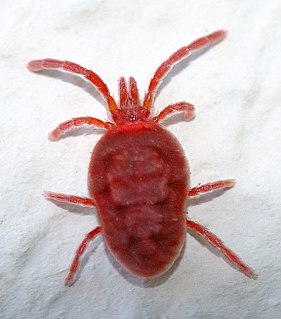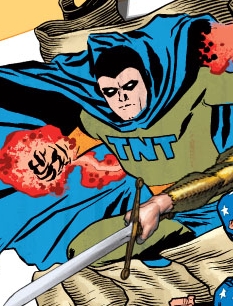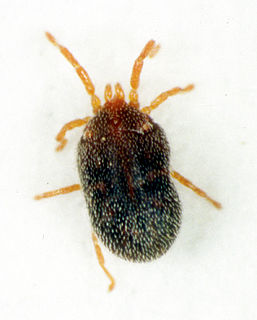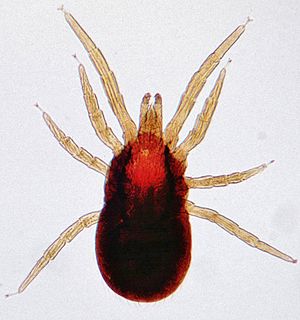
The subphylum Chelicerata constitutes one of the major subdivisions of the phylum Arthropoda. It contains the sea spiders, arachnids, and several extinct lineages, such as the eurypterids and chasmataspidids.

Arachnida is a class of joint-legged invertebrate animals (arthropods), in the subphylum Chelicerata. Arachnida includes orders containing spiders, scorpions, ticks, mites, harvestmen, and solifuges. In 2019, a molecular phylogenetic study also placed horseshoe crabs in Arachnida.

Mites are small arachnids.

The Acari are a taxon of arachnids that contains mites and ticks. The diversity of the Acari is extraordinary and their fossil history goes back to at least the early Devonian period. Acarologists have proposed a complex set of taxonomic ranks to classify mites. In most modern treatments, the Acari are considered a subclass of the Arachnida and are composed of two or three superorders or orders: Acariformes, Parasitiformes, and Opilioacariformes; the latter is often considered a subgroup within the Parasitiformes. The monophyly of the Acari is open to debate, and the relationships of the acarines to other arachnids is not at all clear. In older treatments, the subgroups of the Acarina were placed at order rank, but as their own subdivisions have become better understood, treating them at the superorder rank is more usual.

Sarcoptes scabiei or the itch mite is a parasitic mite that burrows into skin and causes scabies. The mite is found in all parts of the world. Humans are not the only mammals that can become infected. Other mammals, such as wild and domesticated dogs and cats as well as ungulates, wild boars, bovids, wombats, koalas, and great apes are affected.

TNT is a DC Comics superhero from the 1940s. TNT and his side-kick Dan the Dyna-Mite were created by Mort Weisinger for DC Comics, and made their debut in Star Spangled Comics #7.

Demodex folliculorum is a microscopic mite that can only survive on the skin of humans. Most people have D. folliculorum on their skin. Usually, the mites do not cause any harm, and are therefore considered an example of commensalism rather than parasitism. If D. folliculorum does cause disease, this is known as demodicosis.

Dan the Dyna-Mite is a fictional character, a teen-aged superhero published by DC Comics. He was the young sidekick to the character TNT, and was created by Mort Weisinger and Hal Sharp in 1942. TNT and Dyna-Mite made their debut in Star Spangled Comics #7 and starred through #23.

Erythraeidae is a family of mites belonging to the Trombidiformes. Larval forms of these mites are parasitic on various other arthropods, for example harvestmen, but the adults are free-living predators. These oval mites are rather large, usually reddish coloured and densely hairy. The legs, especially the first and fourth pairs, are long and adapted for running. They have either one or two pairs of eyes and can be distinguished from related families microscopically by the presence of a single claw on the tibia of the palp.

Smaridiidae is a family of mites belonging to the order Trombidiformes. These large predatory mites have long oval bodies, distinctively pointed in front. They are usually red and densely hairy with slender legs, sometimes very long. They have either one or two pairs of eyes.
Erythraeus munsteri is a species of mite belonging to the family Erythraeidae. This is a large, oval red mite with a body length of up to 1.5 mm. It has two pairs of eyes and long, slender legs. This mite can easily be distinguished from closely related species by the extraordinarily long, blackish setae which cover the body and legs.

Balaustium medicagoense is a species of mite belonging to the family Erythraeidae. This large, densely hairy mite is up to 1.6 mm in length with one pair of eyes set well back on the body. The first pair of legs is just longer than the body.
Balaustium cristatum is a species of mite belonging to the family Erythraeidae. This oval mite is only known from immature specimens: the eight-legged nymph is around 0.75 mm in length and moderately hairy with two pairs of eyes and all legs shorter than the body. The six-legged larva is only around 0.5 mm in length and sparsely hairy with one pair of eyes and the third pair of legs longer than the body.
Leptus intermedius is a species of mite belonging to the family Erythraeidae. This is a large, oval mite with a total length of 1.7 mm. The body is densely hairy and there is one pair of eyes. The fourth pair of legs is longer than the body. This species has been recorded only in the Bathurst area of South Africa.
Leptotrombidium is a genus of mites in the family Trombiculidae, that are able to infect humans with scrub typhus through their bite. The larval form feeds on rodents, but also occasionally humans and other large mammals. They are related to the harvest mites of the North America and Europe.

Trombiculidae are a family of mites. Chiggers are often confused with jiggers - a type of flea. Several species of Trombiculidae in their larva stage bite their animal or human host and by embedding their mouthparts into the skin causing "intense irritation" or "a wheal, usually with severe itching and dermatitis",

Raoiella indica, commonly known as the red palm mite, is a species of mite belonging to the family Tenuipalpidae. A pest of several species of palm in the Middle East and South East Asia, it is now becoming established throughout the Caribbean. The invasion of this species is the biggest mite explosion ever observed in the Americas.
Ornithonyssus bursa is a species of mite. It is most often a parasite of birds, but also has been found to bite humans and two species of mammals. It usually lives in birds' feathers, but for laying its eggs, it more often uses their nests rather than their feathers. Tropical fowl mites undergo five stages during their development: egg, larva, protonymph, deutonymph, and adult. During the last two stages, they suck blood from their host for food. They are often diurnal, whereas northern fowl mites are nocturnal in nature.

Myobia musculi is a type of fur mite which is found worldwide. It can infest mice and, rarely, other rodents. The Myobia musculi mite has four pairs of legs, but the first pair are very short, as an adaptation to grasping the hair shaft, giving the mite the appearance of having three pairs of legs. The second pair of legs end in empodia. Adult mites are approximately 160–180 μm wide; females are 400–500 μm long, and males are 280–320 μm long.

Mites are small crawling animals related to ticks and spiders. Most mites are free-living and harmless. Other mites are parasitic, and those that infest livestock animals cause many diseases that are widespread, reduce production and profit for farmers, and are expensive to control.















